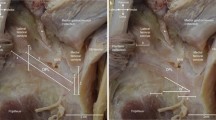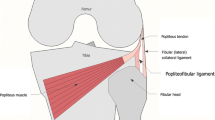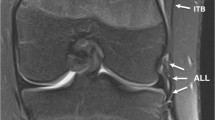Abstract
Objective
Ossification/calcification around the medial femoral condyle has been known as Pellegrini–Stieda (PS) disease for almost 100 years. Little attention has been given to magnetic resonance (MR) imaging characteristics. Our purpose is to demonstrate the anatomy in the medial femoral compartment and imaging findings of PS disease, determining the sites and patterns of ossification.
Design and patients
In a cadaveric study seven specimens were dissected to show the anatomic relations of the tibial collateral ligament (TCL) and the tendon of the ischiocondylar part of the adductor magnus muscle, in the medial femoral epicondyle. In order to determine the nature of ossification/calcification in PS disease, MR imaging and radiographic findings in nine patients were analyzed by two observers with attention to the specific site, shape, and orientation of the ossification and its relationship to the tibial collateral ligament (TCL) and adductor magnus tendon. Available clinical history was recorded. A classification system addressing different sites and patterns of ossification was developed.
Results
The anatomic study showed that the TCL and the adductor magnus tendon insert at different sites in the medial femoral condyle and there is no continuation; however, some fibers of the posterior bundle of the TCL overlap the anterior aspect of the adductor magnus tendon. The imaging study showed that shape, orientation, and location of the abnormal calcification and ossification were similar on radiographic and MR imaging analysis. Ossification had an inferior orientation in six cases, a superior orientation in two cases, and both in one case. Four patterns of ossification were noted: (I) a beak-like appearance with an inferior orientation and femoral attachment was present in five cases; (II) a drop-like appearance with an inferior orientation, parallel to the femur, was evident in one case; (III) an elongated appearance with a superior orientation, parallel to the femur, was seen in two cases; and (IV) a beak-like appearance with an inferior and superior orientation, attached to the femur, was seen in one case. The ossification was present in the TCL in six cases, in the adductor magnus tendon in two cases, and in both in one case. The coronal plane was best in detecting and categorizing the ossification.
Conclusion
Our data indicate that ossification in PS disease is not confined to the TCL but may also involve the adductor magnus tendon. In some cases, it can be related to the anatomic proximity (overlap) of the fibers of these two structures. PS disease should not be regarded as synonymous with ossification of the TCL. The ossification may be classified into four types. No clinical differences among these types appear to exist.





Similar content being viewed by others
References
Wang JC, Shapiro MS. Pellegrini-Stieda syndrome. Am J Orthop 1995;493–97.
Niitsu M, Ikeda K, Iijima T, Ochiai N, Noguchi M, Itai Y. MR imaging in Pellegrini-Stieda disease. Radiat Med 1999;17(6):405–09.
Finder JG. Calcification of the tibial collateral ligament: a report of forty-two cases.J Am Med Assoc 1934;102:1373–75.
Resnick D, Kang HS. Knee. In: Resnick D, Kang HS, editors. Internal derangements of joints: emphasis on MR imaging. 1st edn. Philadelphia: W.B. Saunders; 1997. pp. 555–785.
Mink JH. The cruciate and collateral ligaments. In: Mink JH, Crues III JV, Reicher MA, Deutsch A, editors. Magnetic resonance imaging of the knee. 2nd edn. New York: Raven Press; 1992. pp. 141–88.
Schweitzer ME, Tran D, Deely DM, Hume EL. Medial collateral ligament injuries: evalution of multiple signs, prevalence and location of associated bone bruises, and assessment with MR imaging. Radiology 1995;194:825–29.
Kulowski J. Post-traumatic para-articular ossification of the knee joint (Pellegrini-Stieda’s disease). Am J Roentgenol Radium Ther 1942;47:392–404.
Frohse F, Fraenkel M. Die Muskeln des menschlichen Beines. In: Bardeleben K, editors. Handbuch der Anatomie des Menschen, vol II 2.2B. Jena: Gustav Fischer, 1913;526–8, 536–42, 557–61, 644–52.
Williams PL, Bannister LH, Berry MM, Collins P, Dyson M, Dussek JE, et al. Gray’s anatomy. 38th edn. New York: Churchill Livingstone; 1995. pp. 703, 875, 884.
Aiello L, Dean C. An introduction to human evolutionary anatomy. London: Academic Press; 1994. p. 414.
Howell AB, Straus WL. The muscular system. In: Hartman CG, Straus WL, editors. The anatomy of the rhesus monkey. New York: Hafner; 1971. pp. 89–175.
Ribbing L. Die Muskeln und Nerven der Extremitaeten. In: Bolk L, Goeppert E, Kallius E, Lubosch W, editors. Handbuch der vergleichenden Anatomie der Wirbeltiere. Berlin: Urban & Schwarzenberg, 1938. vol 5, pp. 543–656.
Zuckerkandl E. Zur Anatomie von Chiromys Madagascarensis. Denkschr Akad Wiss Wien, Math-Naturwiss Klasse 1899;68:1–112.
Bergman RA, Thompson SA, Afifi AK, Saadeh FA. Compendium of human anatomic variation. Baltimore, MD: Urban & Schwarzenberg; 1988. p. 24, 26.
Frey H. Der Musculus triceps surae in der Primatenreihe. Gegenbaur’s Morphol Jahrb 1913;47:1–192.
Macalister A. Additional observations on muscular anomalies in human anatomy (3rd series), with a catalogue of the principal muscular variations hitherto published. Trans R Irish Acad 1871;25:1–134.
Pellegrini A. Ossificazione traumatica del legamento collaterale tibiale dell’articulazione del ginocchio sinistro. La Clinica Moderna 1905;433–39.
Stieda A. Ueber eine typische Verletzung am unteren Femurende. Arch Klin Chir 1908:815–26.
Andreesen R. Ueber den Stiedaschen Begleitschatten am inneren Oberschenkelknorren. Arch Klin Chir 1933;162–71.
Pellegrini A. Ossificazioni post-traumatiche pararticolari(O.P.P.) Arch Ital Chir 1938;53:501–63.
Kulowski J. Pellegrini-Stieda’s disease: a report of one case surgically treated. J Am Med Assoc 1933;100:1014–17.
Nachlas IW, Olpp JL. Para-articular calcification (Pellegrini-Stieda) in affections of the knee. Surg Gynecol Obstet 1945;81:206–12.
Puzzas JE, Miller MD, Rosier RN. Pathologic bone formation. Clin Orthop Relat Res 1988;19:269–81.
Author information
Authors and Affiliations
Corresponding author
Rights and permissions
About this article
Cite this article
Mendes, L.F.A., Pretterklieber, M.L., Cho, J.H. et al. Pellegrini–Stieda disease: a heterogeneous disorder not synonymous with ossification/calcification of the tibial collateral ligament—anatomic and imaging investigation. Skeletal Radiol 35, 916–922 (2006). https://doi.org/10.1007/s00256-006-0174-5
Received:
Revised:
Accepted:
Published:
Issue Date:
DOI: https://doi.org/10.1007/s00256-006-0174-5




